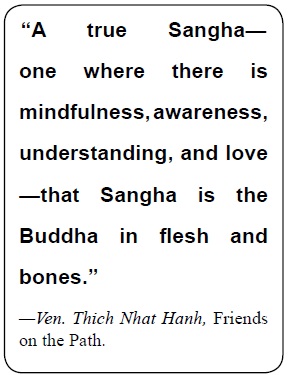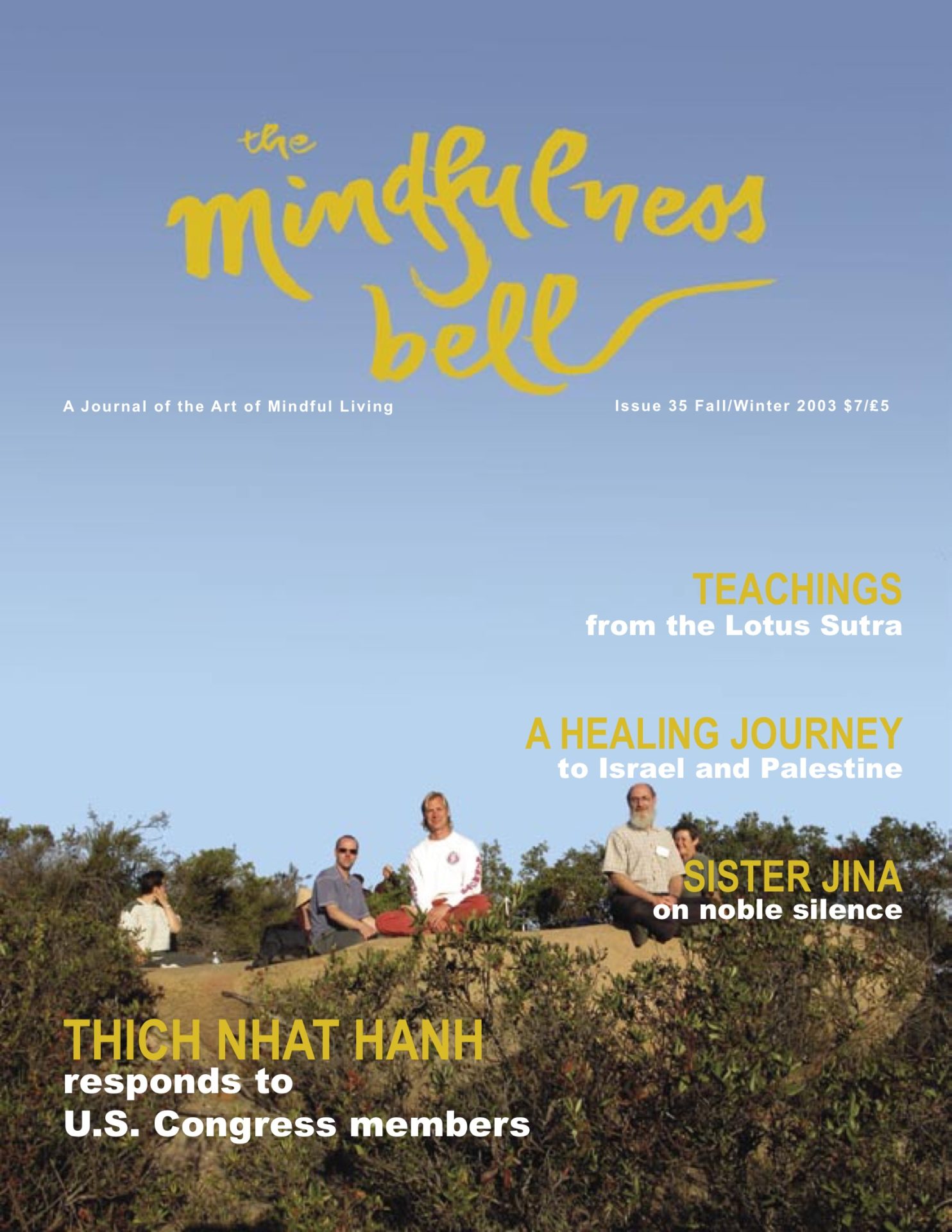Preparing for Thay’s Public Talk in Chicago
By Jack and Laurie Lawlor
Lakeside Buddha Sangha in Evanston, Illinois, was fortunate to facilitate Thich Nhat Hanh’s August 22 public talk on “Building a Century of Peace” at Loyola University Chicago. The event proved to be the largest ever held at the University’s Gentile Center, attracting approximately 5,600 people. Thay has invited us to reflect on the event.
Looking back,
Preparing for Thay’s Public Talk in Chicago
By Jack and Laurie Lawlor
Lakeside Buddha Sangha in Evanston, Illinois, was fortunate to facilitate Thich Nhat Hanh’s August 22 public talk on “Building a Century of Peace” at Loyola University Chicago. The event proved to be the largest ever held at the University’s Gentile Center, attracting approximately 5,600 people. Thay has invited us to reflect on the event.
Looking back, one can see that our ability to offer Thay’s message to so many people was dependent on the collective efforts of the Sangha and its deep, twelve-year-old roots in our community. We all aspired to make the event available to a diverse audience, and the seeds for that opportunity proved to lie within the Sangha itself. For years, graduate students from Loyola University Chicago’s Jesuit seminary have been practicing at Lakeside. With the support of the University’s president, the Jesuit community offered the free use of the University’s largest facility at no cost. This enabled us to place the event in one of Chicago’s most diverse and accessible neighborhoods.

We knew from the outset that the event would be counterproductive if we became anxious or overwrought by all the many details of organizing, so we made a conscious decision to devote the same heightened degree of mindfulness often reserved for retreat to our earliest organizing efforts. We also decided to plan early and to implement our activities in an orderly fashion.
We began by drawing upon the talent and experience of Sangha members who had organized similar talks. This helped immensely. For example, Brother Phap Kham gave us a clear sense of the rhythm we should apply in doing our print advertising, mailings, and similar communications. Others offered helpful insights about publicity and how to organize volunteers to facilitate a large audience.
We drew upon local Sangha talent by holding three large Sangha-wide planning sessions. There we identified local ticket vendors, and with Brother Phap Kham’s help in setting up Ticketweb sales, we were ready to employ our earliest waves of publicity. First, we sent packages of posters produced with the help of Lien Ho of the Deer Park community to local interfaith networks, Buddhist temples and centers, community groups, and peace activists. Loyola University also spread the word to Catholic peace organizations and innumerable parishes and interfaith groups. We were delighted when a network of fifty Chicago area community activists from the historic Industrial Areas Foundation invited us to speak about Thay and mindfulness practice. With the technical help of Northwestern University students, we created a Web page complete with vendor information, travel instructions and maps. As a result, we sold approximately 1,000 tickets before our first print advertising appeared, about two months before the event. This included over 150 press releases sent to small community newspapers, television, and radio stations after an extensive review of Chicago media guides, in an effort to attract a diverse audience. As the event grew near, we appeared in the weekly free press, in monthly healthy living magazines, and in the Chicago Tribune.
With over 3,000 tickets distributed, it was time to organize for the event itself. Here is where years of Sangha-building bore fruit. After meeting several times with Loyola University’s staff, we had a clear grasp of the facility and the challenges we would face in seating such a large audience in an athletic center. We held another Sangha planning session, and after several weeks of recruiting had enlisted over eighty volunteers willing to help out. We rented walkie-talkies to coordinate the volunteers who directed patrons from University parking lots and transit stations. We located two “signers” to deliver Thay’s talk to the hearing impaired, who with the elderly and handicapped were provided special seating.
As the event drew near, we placed fifteen-second spots on public radio and a sixty-second spot on the local classical music station, each of which was broadcast for five days. These proved to be extremely effective, as all remaining seats were filled in less than one week.

The Event
After ten months of continuous planning, the day of the event arrived. Our local Sangha, together with members of the monastic community, arrived hours early to prepare the building. Three hours before his public talk, Thay accepted an honorary doctorate and spoke to Loyola’s incoming freshman students and their parents, who were enjoying their first day on campus. Loyola is integrating Thay’s teaching into its courses, requiring the freshmen to study several of Thay’s books! This event served as a “practice” session for our evening talk, and everything, including the sound system, worked perfectly.
It was both inspiring and startling to see over 5,000 people stream into the building a few hours later. At Thay’s request, each person was handed a small sheet of paper containing instructions in mindful breathing and describing how everyone would be practicing sitting meditation in silence at their seats while the audience was assembling. Upon entering the meditation hall, it was striking to see Thay meditating in the lotus position on the stage in the company of eighty monks and nuns, with the backdrop of a lovely altar and flower arrangements designed and assembled by local Sangha members.
As the Buddha reminds us, life contains impermanence and surprise. Our biggest surprise was that the sound system that had worked so well while Thay stood and addressed the freshmen approximately three hours earlier was incapable of reaching everyone once Thay was seated, using a combination of lapel and lavalier microphones. Those in the highest seats, located closest to the building’s air vents, had to strain to hear Thay’s gentle voice through the “white noise” of vent fans. Thay generously invited those folks to sit on the floor nearest him. Other problems with the microphones weren’t resolved until after the first third of Thay’s talk, just in time for several rounds of applause as Thay offered insights into the challenges facing American society.
We were deeply sorry that, for various reasons, a portion of the audience could not hear Thay to their satisfaction. For those unable to hear no matter what we did, we promptly offered and subsequently provided refunds to over 100 people. The transcript of Thay’s talk is available at www.LakesideBuddha.com, thanks to the help of volunteers.
Done completely through volunteer effort, this is an example of what the maha-Sangha can collectively accomplish. There could not have been a better time to offer Thay’s message of peace. Let us hope that our local Sanghas can help nurture the seeds of Thay’s message in our communities in order to lessen the odds that our society will lurch from one crisis to the next without looking deeply into the underlying causes and conditions. As Thay reflects in For a Future to be Possible, “Good practitioners always keep Sangha-building in mind. Sangha-building is the work of months and years ... We have to pool our strength in order to build a Sangha.”
Jack and Laurie Lawlor are Dharma teachers and founders of the Lakeside Buddha Sangha in Chicago, Illinois.

